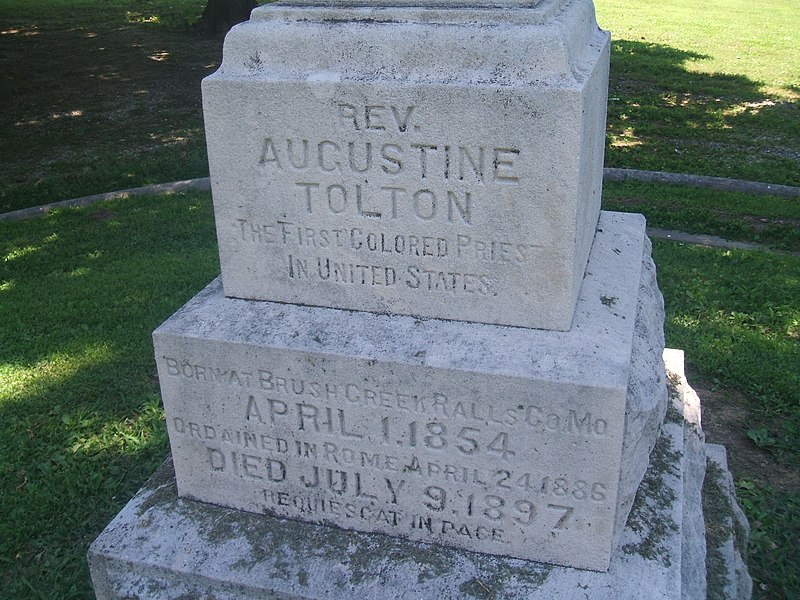Out of about a dozen Saints from the United States, none of them is black and that could change in a few years as the pope has placed the first African-American priest and a former slave on the path to sainthood. Father Augustine Tolton is one of five African American Catholics who are the focus of campaigns by black Catholics in the U.S. to advance their sainthood and change the perception of institutional racism bedevilling the Church.

The others are Pierre Toussaint, a former slave and New York City philanthropist, There’s Julia Greeley, a former slave who distributed charity to the needy in Denver, Henriette Delille of New Orleans and Mary Elizabeth Lange of Baltimore who both founded religious orders.
Augustus Tolton, baptized Augustine Tolton in St. Peter’s Catholic Church in Brush Creek, was born in Missouri to enslaved parents Peter Paul Tolton and his wife Martha Jane Chisley on April 1, 1854.
Their master, Stephen Elliott, was a Catholic who imposed his faith on his slaves. Tolton and his family gained freedom at the start of the American civil war with divergent stories of how they escaped.
Some accounts said Father Tolton had told friends and parishioners that his father escaped and then joined the Union Army while his mother ran with him and his three siblings and crossed the Mississippi River into the free state of Illinois with the help of Union soldiers. However, descendants of the Elliott family say their ancestor freed all his slaves and allowed them to move to the North at the outbreak of the War.
Tolton worked with his siblings at a tobacco company in Illinois where they held onto their Catholic faith. He gained more interest in the faith after he met Irish immigrant priest Father Peter McGirr who gave him the opportunity to attend St. Peter’s parochial school despite the racism at the time even in the parish.
Subsequently, Tolton was rejected in all American seminaries he applied to and McGirr sponsored him to study in Rome where he graduated from St. Francis Solanus College (now Quincy University) and became fluent in Latin, Greek and the Italian language after attending the Pontifical Urbaniana University.

A 31-year-old Tolton was ordained as a priest in Rome in 1886 where he served his first Mass. His dream of serving as a priest in Africa was shattered when he was directed to serve the black community in the U.S.
He faced resistance from white Catholics and Protestant blacks since his first U.S. Mass at St. Boniface church in Quincy where he had wanted to organize a parish, a Catholic church and school.
He gained the attention of the national Catholic hierarchy after he was reassigned to Chicago where he developed a Negroe national parish which grew with hundreds of parishioners and a new church built with money from philanthropists Mrs. Anne O’Neill and Saint Katherine Drexel.
Father Tolton, popularly referred to as “Good Father Gus”, was widely covered in the news and several articles were written about his fluency and sweet singing voice as well as his influence in the establishment of several African American Catholic churches in Chicago.
He was afflicted with many illnesses which forced him to take a temporary leave of absence at the St. Monica’s Parish in 1895. He died a day after he collapsed on July 8, 1897, at the Mercy Hospital following a heat wave in Chicago that year. He was 43.

Father Augustine Tolton was buried in the priests’ lot in St. Peter’s Cemetery in Quincy as he had wished. He is the subject of a 1973 biography From Slave to Priest by Sister Caroline Hemesath. He also has several educational institutions named after him.
After a five-year investigation in Chicago by the Church’s historical and theological commissions, Pope Francis approved on June 12, 2019, a decree recognising Tolton’s heroic virtues, a move that kick starts the canonization. Tolton has now been granted the title “Venerable” which means Catholics can pray to him for intercession with God.
As part of the canonization process, his remains were exhumed on December 10, 2016, and verified by a forensic pathologist.

Pierre Toussaint who died on June 30, 1853, at the age of 87, was also declared Venerable by Pope John Paul II on December 17, 1997 for his outstanding service to his people and society. However, he has since not moved on to the next phase of canonization.
For both Tolton and Toussaint to move to the next phase which is beatification, one miracle would have to be attributed to them. And the final phase is when a second miracle is attributed to them and also proved by the Vatican. This would complete the canonization process and they will be declared saints.
It could take five years to a century for this to happen.










